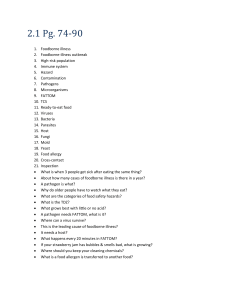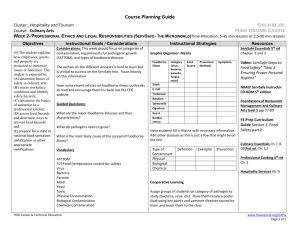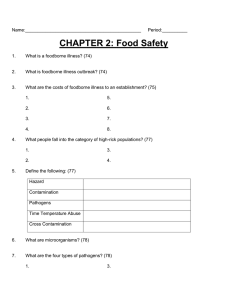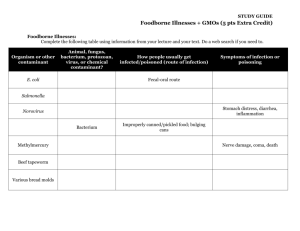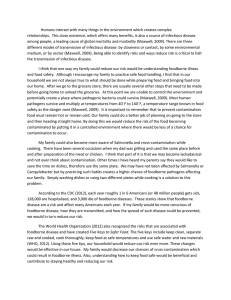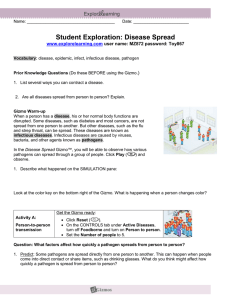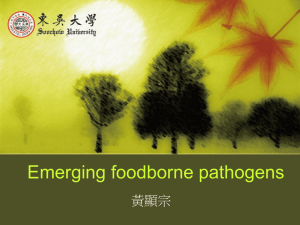Food Safety Research Consortium
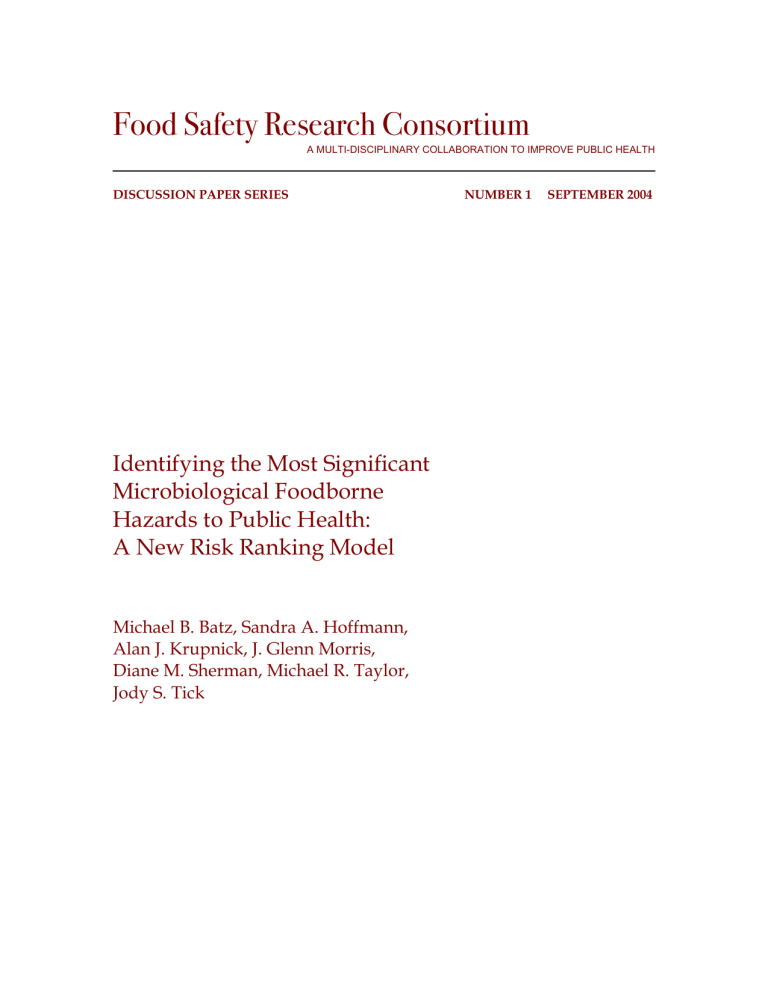
Food Safety Research Consortium
A MULTI-DISCIPLINARY COLLABORATION TO IMPROVE PUBLIC HEALTH
DISCUSSION PAPER SERIES NUMBER 1 SEPTEMBER 2004
Identifying the Most Significant
Microbiological Foodborne
Hazards to Public Health:
A New Risk Ranking Model
Michael B. Batz, Sandra A. Hoffmann,
Alan J. Krupnick, J. Glenn Morris,
Diane M. Sherman, Michael R. Taylor,
Jody S. Tick
Identifying the Most Significant Microbiological Foodborne
Hazards to Public Health: A New Risk Ranking Model
Michael B. Batz, Sandra A. Hoffmann, Alan J. Krupnick, J. Glenn Morris,
Diane M. Sherman, Michael R. Taylor, and Jody S. Tick
Abstract:
In order to help facilitate a risk-based food safety system, we developed the Foodborne
Illness Risk Ranking Model (FIRRM), a decisionmaking tool that quantifies and compares the relative burden to society of 28 foodborne pathogens. FIRRM estimates the annual number of cases, hospitalizations, and fatalities caused by each foodborne pathogen, subsequently estimates the economic costs and QALY losses of these illnesses, and, lastly, attributes these pathogen-specific illnesses and costs to categories of food vehicles, based on outbreak data and expert judgment. The model ranks pathogen-food combinations according to five measures of societal burden. FIRRM incorporates probabilistic uncertainty within a Monte Carlo simulation framework and produces confidence intervals and statistics for all outputs. Gaps in data, most importantly in regards to food attribution and the statistical uncertainty of incidence estimates, currently limit the utility of the model. Once we address these and other problems, however, FIRRM will be a robust and useful decisionmaking tool.
Key Words: foodborne illness, risk ranking, pathogens, health valuation, QALYs, cost of illness, uncertainty, modeling, Monte Carlo
Contents
Introduction
........................................................................................................................ 1
Materials and Methods
................................................................................................. 2
Results and Discussion
............................................................................................... 13
Tables
.................................................................................................................................. 17
References
......................................................................................................................... 23
Identifying the Most Significant Microbiological Foodborne Hazards to
Public Health: A New Risk Ranking Model
Michael B. Batz, Sandra A. Hoffmann, ∗ Alan J. Krupnick, J. Glenn Morris,
Diane M. Sherman, Michael R. Taylor, and Jody S. Tick
Introduction
The National Academies of Science, federal food safety agencies, the U.S. General
Accounting Office, and numerous other expert bodies embrace the goal of a science- and risk-based food safety system (NRC 1998, 2003; GAO 1997, 2001). In such a system, risk managers prioritize food safety hazards and preventive interventions using the best available data on the distribution of risk and on how risk can be reduced most effectively and efficiently (Taylor and Hoffmann 2001). This requires taking a more integrated systems approach to reducing foodborne illness. Regulators must understand the many factors that contribute to the causation and prevention of foodborne illness from the point of production to the point of consumption and must be able to systematically target efforts in ways that contribute most effectively to risk reduction.
This approach to food safety requires decisionmaking tools and data that, with few exceptions, do not currently exist (Taylor et al. 2003). Specifically, decisionmakers need tools to: (1) identify the most significant risks from a public health perspective;
(2) prioritize opportunities to reduce risk, taking into account the feasibility, effectiveness, and cost of possible interventions; and (3) allocate their efforts and resources accordingly.
∗
Hoffmann is the corresponding author and can be reached at hoffmann@rff.org
. All other authors except J. Glenn
Morris can be reached at Resources for the Future, 1616 P Street NW, Washington, DC 20036. Morris is the chair of the department of epidemiology and preventive medicine, University of Maryland School of Medicine, Baltimore,
Maryland.
1
Food Safety Research Consortium Batz et al.
To address the first need, we created the Foodborne Illness Risk Ranking Model
(FIRRM), an analytical software tool designed to enable decisionmakers to identify, compare, and rank the relative public health impact of 28 foodborne pathogens.
Specifically, FIRRM is intended to rank pathogen-food combinations according to five measures of public health impact: estimated number of cases, hospitalizations, and deaths, as well as estimated economic impact and loss of Quality Adjusted Life Years
(QALYs). FIRRM is the first comprehensive model to attribute estimates of microbiological foodborne illness to specific pathogen-food combinations, to employ economic and QALY valuation, and to use Monte Carlo simulation to quantify uncertainty.
In doing so, the model combines and furthers much of the research on the topic.
This research includes estimates of the incidence of foodborne illness by the Centers for
Disease Control and Prevention, or CDC, (Mead et al. 1999) and cost-of-illness studies by the USDA’s Economic Research Service, or ERS, (Buzby et al. 1996, Buzby and
Roberts 1996, Buzby and Roberts 1997, Frenzen 1999, ERS 2003). It also employs risk assessments by the Food and Drug Administration (FDA), USDA’s Food Safety and
Inspection Service (FSIS), and others (CFSAN 2000, CFSAN 2003, FSIS 1998, FSIS 2001) and a dataset created by the Center for Science in the Public Interest (CSPI) in which outbreaks are linked to causal food vehicles (DeWaal and Barlow 2002).
Materials and Methods
Presently, FIRRM focuses solely on microbiological foodborne hazards. Chemical as well as waterborne and environmental microbiological risks are clearly important, but require distinct modeling efforts that can be incorporated into the model later. From a regulatory and policy perspective, it is essential that we know which foods are responsible for specific illnesses as well as the relative contribution of these foods to the total disease burden associated with specific foodborne pathogens. Consequently, the
2
Food Safety Research Consortium Batz et al.
model addresses pathogen-food combinations rather than focusing solely on pathogens.
Incidence estimates alone are not sufficient for the comparison of illnesses because different symptoms and severities are associated with different pathogens. The model therefore includes economic and QALY valuation, which incorporate public preferences, to provide a way of comparing different illnesses using a common metric.
Finally, the model builds uncertainty into its input variables and results through Monte
Carlo simulation, as point estimates exaggerate confidence and may misrepresent the true state of knowledge.
We created FIRRM using Analytica software, a visual modeling and Monte Carlo simulation environment in which mathematical models are developed using functional influence diagrams. Analytica was explicitly designed for risk analysis and riskinformed decisionmaking and is therefore well suited to our functional model needs.
Analytica’s visual approach and features also meet our usability objectives of transparency, flexibility, adaptability, and accessibility.
Modeling Approach: FIRRM uses a “top-down” epidemiological approach rather than a “bottom-up” microbiological approach to estimating illnesses. To estimate illnesses due to pathogen-food combinations, FIRRM uses surveillance data on pathogen illnesses and then traces these illnesses back to food origin. This is distinguished from conventional risk-assessment approaches, which use food contamination data, predictive microbiology, and consumption patterns to estimate illnesses.
As we are most concerned with ranking public health impacts, we decided to start with observable data gathered as close to these health outcomes as possible, rather than rely on predictions of illnesses based on modeling of microbial risk. In addition, using a predictive microbiological approach would imply performing separate risk assessments on thousands of individual pathogen-food combinations, a frankly impossible task. Finally, for the purpose of risk ranking, computations and data should
3
Food Safety Research Consortium Batz et al.
be consistent across ranked items. A top-down approach ensures identical methodology across pathogen-food combinations; individual risk assessments are not nearly so directly comparable. Although the top-down approach is preferable for a big-picture comparison of foodborne risks, it is inadequate to isolate the causes of illness along the farm-to-table pathway.
Model Design: FIRRM is composed of three major modules: incidence, valuation of health impacts, and food attribution. In the first module, the annual number of cases, hospitalizations, and deaths from 28 foodborne pathogens are estimated from public health surveillance data; this module includes estimates for the United States as a whole, as well as for the state of Maryland. In the second module, the economic cost and QALY loss associated with a single case of illness are computed for individual pathogens. The third module consists of pathogen-specific food attribution percentages; illnesses from each pathogen are attributed, by percentage, to some set of food vehicles.
As discussed in depth at a recent FSRC workshop (FSRC 2003), a fully adequate source for such food-attribution data does not currently exist. Consequently, the model includes two approaches and data sources: (1) outbreak data, which are easily accessible but can offer a distorting picture of risks as cases not tied to an outbreak are ignored and (2) an expert elicitation, which develops attributions based on judgments of food safety experts and may, to some extent, depend on outbreak data (see FSRC 2003 for more detail on these approaches). We have also worked on development of an algorithm to estimate food-attribution percentages based on levels of microbial contamination and food consumption. However, at its current state of development
(and reliance on the inconsistent data on food contamination available from published sources), the algorithm does not provide useable solutions.
Estimates of National Incidence: Estimates of the national incidence of pathogen-specific foodborne illnesses are based on the data and methods described in detail in Mead et al. (1999). This approach relies heavily on multiplicative parameters
4
Food Safety Research Consortium Batz et al.
representing his best judgment on underreporting. Rather than include only his final estimates, Mead’s approach and data were built into the model to allow these parameters to be changed, data to be updated, and to allow for the incorporation of uncertainty into Mead point estimates.
Mead bases his estimates on incidence data on 28 bacterial, viral, and parasitic pathogens (see Table 1) from active, passive, and outbreak surveillance sources. The average values of this data are then multiplied by underreporting factors to obtain estimates of the annual number of cases, hospitalizations, and deaths associated with
1 These estimates are multiplied by the percent of illnesses due to each
pathogen estimated to come from foodborne sources. Thus, following the Mead approach, annual foodborne cases of illness ( fbcases p
) of pathogen p can be expressed as fbcases p
= repcases p
* curf p
* surf p
* pctfb p
, (1) where repcases p
is the average annual number of reported cases of illness cause by pathogens, curf p
is the pathogen-specific underreporting factor based on illness symptom severity, surf p
is a sporadic underreporting factor for illnesses estimated from outbreak data, and pctfb p
is the percent of total illnesses estimated to be due to foodborne sources. Similarly, hospitalizations ( fbhosps p
) and deaths ( fbdeath p
) due to these foodborne pathogens can be represented by fbhosps p
= repcases p
* rephrate p
* hurf p
* pctfb p
, and (2) fbdeath p
= repcases p
* repdrate p
* durf p
* pctfb p
, (3)
1 Of 28 pathogens included, estimates for 11 are based on active surveillance data, seven are based on passive surveillance data, and six are based on outbreak surveillance data. Four are based on nonsurveillance data: estimated annual cases due to Toxoplasma gondii , Norovirus, Rotavirus, and
Astrovirus are based on estimated infection rates applied to the U.S. population. Hospitalizations and deaths for these four pathogens plus Giardia lamblia are similarly computed from nonsurveillance data.
Incidence estimates based on nonsurveillance data do not use underreporting factors.
5
Food Safety Research Consortium Batz et al.
where rephrate p
is the reported hospitalization rate ( hurf p
) is the hospitalization underreporting factor ( repdrate p
) is the reported death rate, and durf p
is the underreporting factor for deaths.
Mead uses point values for all estimates and thus excludes uncertainty from the analysis. For example, Mead reports the range of underreporting associated with
Escherichia coli O157:H7 cases from a single study to be between 13 and 27, but only uses the midpoint of 20 in calculations. As a result, although Mead estimates 62,458 annual cases of foodborne E. coli O157:H7, the uncertainty associated with the underreporting factor implies a possible range of cases from 41,598 to 84,318, or a range of plus-orminus 35% around the point estimate. Placeholder variables for uncertainty are built into the structure of the model, but as Mead does not report uncertainty values for many key parameters, these variables are largely devoid of values. Using the model’s default settings, therefore, estimates of national foodborne incidence are point estimates.
Estimates of Maryland Incidence: The model estimates incidence of nine pathogens for the state of Maryland based on active surveillance data collected as part of the CDC’s FoodNet program (CDC 1997, 2003).
2 This submodule was designed to
provide an example of how annual FoodNet data could be used to produce regularly updated estimates of incidence, in contrast to Mead’s snapshot estimates (1999).
The dataset included over 1,500 entries of culture-confirmed cases in 1998 and
1999, cleaned of personal identifiers, with the following variables: isolate, serotype, sex, age, sample location, sample source (stool, blood, and so on), month, dates of hospitalization, and outcome (recovered, died, unknown). From these data, we counted the annual number of total reported cases, reported hospitalized cases, reported
2 The nine FoodNet pathogens are: Campylobacter spp., Cryptosporidium spp., Cyclospora , E. coli O157:H7,
Listeria monocytogenes , non-typhoidal Salmonella , Shigella spp., Vibrio spp., and Yersinia enterocolitica .
6
Food Safety Research Consortium Batz et al.
physician visits, and reported cases resulting in death. To estimate illnesses from reported data, we used underreporting factors taken from the national 1998 FoodNet
Physician Survey and the national 1998–99 FoodNet Community Survey (Imhoff et al.
2000). Whereas Mead’s underreporting factors are pathogen-specific but static over time, FoodNet underreporting factors change over time but are not pathogen-specific.
The total number of annual cases of illness ( cases pt
) for pathogen p and year t is defined as cases pt
= hvis pt
+ phvis pt
+ nophvis pt
. (4)
For pathogen p and year t annual physician visits ( phvis pt
) are estimated by multiplying the number of reported physician visits by an underreporting factor to account for the fact that doctors don’t submit samples for every case of diarrheal illness. This underreporting factor is defined as a uniform distribution between two estimates: one drawn from the physician survey and one drawn from the community survey (Imhoff et al. 2000). A small percent of reported physician visits result in hospitalization; these cases must be subtracted from the count of physician visits and included in estimates of the more severe category of hospitalizations. We define the percent of miscategorized physician visits as a uniform distribution between zero and an estimate of this percent from the community survey (Imhoff et al. 2000). Annual hospitalizations ( hvis pt
) are therefore defined as the sum of reported hospitalizations and miscategorized physician visits. Estimated cases with no medical attention
( nophvis pt
) are estimated by multiplying estimated physician visits by an underreporting factor based on the community survey that estimates the number of illnesses in the community for each illness resulting in physician care.
FoodNet collects no data on underreporting of deaths, therefore estimated deaths
( death pt
) is assumed equal to reported deaths.
7
Food Safety Research Consortium Batz et al.
As Maryland FoodNet data was collected in 1998 and 1999 only for the Baltimore metropolitan area, incidence estimates are scaled up to statewide estimates using U.S.
Census county-level population data. Estimates of total annual foodborne cases
( fbcases p
) may be therefore be expressed as fbcases p
= pctfb p
1
*
T
T
∑
t cases pt
*
PopM t
,
(5)
PopB t where PopM t
is the population of Maryland in year t , PopB t
is the population of
Baltimore for the same year, pctfb p
is the estimated percent foodborne, as drawn from
Mead, and T is the total number of years of data. Foodborne hospitalizations ( fbhosps p
) and deaths ( fbdeath p
) are calculated similarly. While national incidence estimates are point values, Maryland incidence estimates are distributions.
Economic Valuation of Health Effects: FIRRM includes two alternative measures of the economic value of avoiding adverse health effects: cost-of-illness (COI) and willingness-to-pay (WTP). COI is defined as the direct market costs of illness, primarily medical costs and labor market productivity losses. It is widely used in regulatory analysis because it is easy to estimate, but economists agree that it undercounts the economic value of avoiding illness. Economists generally recognize
WTP as a more complete health valuation measure. It measures the value that individuals place on specific risk reductions in order to obtain the benefits of such risk reductions (Freeman 2003).
COI and WTP measures are used to value outcomes from health-outcome trees developed in studies from the USDA Economic Research Service (ERS) on the costs of bacterial foodborne disease (Buzby et al. 1996, Buzby and Roberts 1996, Buzby and
Roberts 1997, Frenzen 1999, ERS 2003). In these health-outcome trees, total cases of illnesses from a particular pathogen are mapped by symptom, severity, and medical attention required into health-outcome trees unique to each pathogen. Rates of hospitalization, death, and other health effects are used to estimate the annual number
8
Food Safety Research Consortium Batz et al.
of cases of each health state in the outcome tree. For each health state i , the number of cases is multiplied by the economic value per case of avoiding that health state
( valperhs i
). Thus, the economic impact of foodborne illnesses due to pathogen p (fbval p
) may be expressed as fbval p
= fbcases p
I
∑
i
( i
* i
)
, (6) where fbcases p is the number of foodborne cases of pathogen p as defined in equations
(1) and (4), and pcths i
is the likelihood of health state i . The total number of health states
(I) varies by pathogen.
FIRRM includes health-outcome trees for four pathogens— Campylobacter ,
Escherichia coli O157:H7, Listeria monocytogenes , and nontyphoidal Salmonella —drawn directly from ERS studies. We did not create health-outcome trees for additional pathogens due to resource limitations. Although most data in the health-outcome trees are drawn from ERS studies, the two major exceptions are the hospitalization rate and fatality rate. Both national and Maryland estimates of these rates are derived from incidence estimates. Some assumptions in FIRRM also differ from those of ERS. These differences are described in detail in internal model documentation and can easily be changed in the model by the analyst to match ERS assumptions.
COI and WTP estimates for the economic impact of health states are drawn from existing studies, with those on cost-of-illness drawn from ERS studies. Deriving estimates for WTP values is highly resource-intensive, and therefore they are not available for all health states. Estimates of WTP to reduce mortality risk are much more common than those for morbidity. Estimates of WTP to reduce mortality risk
(commonly referred to as the value of a statistical life (VSL)) are taken from several studies, some of which vary by age and some of which do not (Krupnick et al. 2002;
Landefeld and Seskin 1982; Mrozek and Taylor 2002; Viscusi 1993; EPA 1997, 1999).
These include studies used by ERS and the Environmental Protection Agency in their
9
Food Safety Research Consortium Batz et al.
regulatory benefits analysis. For health states without available WTP values, empty placeholder variables are built into the model; COI estimates are used as default values.
Further research is needed to provide estimates of WTP to fill in these placeholder variables.
QALY Valuation of Health Effects: FIRRM also includes valuation of health effects in Quality Adjusted Life Years (QALY), an alternative to economic valuation commonly used in the public health community (Gold 1996). QALY loss is computed in the model similarly to economic cost; health states in a pathogen’s health-outcome tree are individually valued and summed. Thus, the QALY loss of foodborne illnesses
( fbqaly p
) due to pathogen p , may be expressed as fbqaly p
= fbcases p
I
∑
i
( i
* i
),
(7) where qalyperhs i
is the per-case QALY loss of a health state i , and the remaining variables are the same as defined in equation (6).
QALYs are estimated for a health state by multiplying a health index, defined as a value between zero for death and one for perfect health, by the duration of the health state in years. There are numerous health indices available to estimate QALYs based on different approaches and assumptions. FIRRM uses the Quality of Well-Being (QWB) index, which is based on four component scores —Mobility, Physical Activity, Social
Activity, and Symptom/Problem Complex —that are computed for each health state
(Kaplan et al. 1979, Kaplan et al. 1998). The QWB index was selected for ease of use and because resource limitations precluded the extensive research required to implement the Health Utility Index (Feeny et al. 1996; Furlong et al. 1998) or other indices.
In our model, QALY loss is defined as the difference between the baseline health index of a population and the health index associated with a particular negative health state, multiplied by the average duration of the health state. Thus, the per-case QALY loss ( qalyperhs i
) of health state i , as required for equation (7), can be expressed as
10
Food Safety Research Consortium Batz et al.
qalyperhs i
= (qwb baseline
– qwb i
) * dur i
, (8) where qwb baseline
and qwb i
are the QWB scores for the baseline health state and a health state, i , respectively, and dur i
is the duration of that health state.
Food Categories for Food Attribution: To attribute illnesses to foods, FIRRM relies on a two-tier food categorization scheme adapted from the scheme developed by
Center for Science in the Public Interest (CSPI) for their analyses of outbreak data from
CDC and other sources (DeWaal and Barlow 2002). We modified the CSPI food categorization scheme to make it more appropriate for the model; the final scheme is shown in Table 2. The model’s food categories are explained in more detail in FSRC
(2002) and in internal model documentation.
Food Attribution from Outbreak Data: The outbreak method of food attribution is based on analysis of CSPI’s compilation of outbreak data, in which each outbreak has been traced to an implicated food vehicle. These data include primarily unpublished
CDC data obtained through Freedom of Information Act requests, but also include additional outbreak reports collected and verified by CSPI. Of the 2,472 outbreaks listed in the September 2002 Outbreak Alert, 300, or 12.1%, were not from CDC sources (DeWaal and Barlow 2002). After pathogens not in FIRRM were excluded, the dataset contained entries for 1,977 outbreaks, representing 83,619 individual cases of foodborne illness.
The food vehicles in the outbreak attribution dataset were categorized into the two-tier scheme previously discussed. For each pathogen, food-attribution percentages were computed by dividing the number of cases due to each pathogen-food combination by the total number of cases due to that pathogen. Food-attribution percentages therefore sum to 100% for a single pathogen across all food categories.
Food Attribution from Expert Elicitation Results: We designed and implemented an expert elicitation survey, in which experts were asked to estimate, for
11
Food Safety Research Consortium Batz et al.
each pathogen, the percentage of illnesses attributable to each food vehicle. The survey was developed, with the aid of Dr. Paul Fischbeck, Carnegie Mellon University, a recognized authority in the field of expert elicitation, using standard methodologies found in the literature (Morgan et al. 1990; Cooke 1991). The survey included 11 major pathogens and elicited uncertainty bounds around responses.
peer-reviewed list of 101 scientists, public health officials, and food safety policy experts; we received 45 responses. The model includes an average of experts’ best judgment estimates of attribution percentages. Work is under way to further analyze
Computing Rankings: To compute risk rankings, the model combines results from the three aforementioned modules. For each pathogen, foodborne incidence from the first module and valuation of health outcomes from the second module are multiplied by the food attribution percentages from the third module to obtain incidence and valuation by pathogen-food combination. The primary output of the model is a risk ranking of pathogen-food combinations, sorted by one of the five measures of estimated annual public health burden: number of total cases, number of hospitalizations, number of deaths, economic cost, and QALY loss.
3 The survey asked respondents to give low, high, and best-guess estimates and asked them to rate their expertise on individual pathogens and individual food categories on a scale from 1 to 5.
4 The model also includes the option of using the results of a series of risk assessments on Listeria monocytogenes in 23 ready-to-eat (RTE) foods performed by FDA, USDA, and CDC (CFSAN 2003). The risk assessments estimated the number of annual illnesses due to Listeria in each food item, which were classified into the major food categories in the model. Food attribution percentages were computed by dividing the number of estimated cases in each food category by the total estimated cases of Listeria from all 23 risk assessments.
12
Food Safety Research Consortium Batz et al.
Results and Discussion
The results produced by FIRRM are only preliminary. There are a significant number of areas in which data are missing or thin; there are other modules, namely in valuation and food attribution, that have yet to be fully designed and programmed; and uncertainty is not fully incorporated into many model input variables. Thus, it would be premature for us to draw strong policy conclusions from the ranking results produced by the model. Nonetheless, results strongly support the value of the underlying methodology to food safety policy analysis and highlight the importance of some key attributes of the model.
Pathogen-Food Combinations: The results show quite clearly how risk rankings are sensitive to whether pathogens or pathogen-food combinations are being ranked.
For example, Table 3 shows that while only three pathogens cause the vast majority of annual foodborne hospitalizations, these illnesses are spread across a large number of foods. The top-ranked pathogen may be Norovirus, but Salmonella in egg dishes is the most significant pathogen-food combination. This type of ranking enables the comparison of specific disease pathways in the food safety system and points towards development of more efficient intervention strategies.
Measures of Public Health Burden: The results show that rankings are sensitive to the outcome measure. For the four pathogens for which economic and QALY valuation were completed, Table 4 shows that while Campylobacter causes more cases of foodborne illness than any of the other pathogens, Salmonella causes the most hospitalizations and deaths and is likewise the most expensive. Economic valuation is driven largely, though not entirely, by the value of statistical life (VSL) used to value mortality risks. The default VSL is $2.39 million (2001$), drawn from Mrozek and
Taylor (2002); if a significantly lower VSL is chosen, such as Krupnick’s $720,000 (2001$) estimate (2002), Campylobacter becomes the most expensive pathogen due to its greater incidence. Salmonella and Listeria have similar economic costs for although Salmonella is
13
Food Safety Research Consortium Batz et al.
associated with far more hospitalizations; Listeria hospitalizations are far more severe and costly. Estimates of QALY loss for the two pathogens differ greatly, however, because of the difference in the age distributions of those affected. As those who die from Salmonella are, on average, much younger than those who die from Listeria , the number of life years lost per case (assuming a baseline population lifespan) are greater for Salmonella .
Food attribution complicates the matter. Table 5 shows the same pathogen-food combinations shown in Table 3 for all five health-outcome measures, sorted by hospitalizations. There is little agreement as to which is the most significant public health risk; Salmonella from egg dishes, Norovirus from shellfish, and Listeria from luncheon meats all rank highest by different outcome measures. As the model only includes economic valuation for four pathogens, these values are missing for some key pathogen-food combinations. Indeed, these missing values suggest the importance of completing economic valuation components of the model for both Norovirus and
Toxoplasma .
Methods of Food Attribution: Table 6 shows food-attribution percentages for
Campylobacter and Listeria using the expert elicitation, outbreak data, and a series of
Listeria risk assessments. According to outbreak data, only 16% of Campylobacter illnesses are due to the food category of “Poultry.” Experts note the limitations of outbreak data for a largely sporadic illness with few outbreaks and estimate that percentage to be nearly 70%, citing a reliance on case control data. Percentages for
Listeria show greater similarities across attribution methods, though they still differ.
Listeria outbreaks were recorded only in four food categories, whereas experts associate at least minor Listeria risk with every food category. Food-attribution percentages drawn from the CFSAN/FSIS risk assessment on Listeria monocytogenes are also shown, though they are not directly comparable to the other two approaches, as the risk assessments were only performed on 23 ready-to-eat food items in only five of the
14
Food Safety Research Consortium Batz et al.
model’s food categories. Nonetheless, the risk assessments agree with the two other approaches that luncheon meats and dairy are the two most important food categories for Listeria .
Uncertainty: The model includes various measures of statistical uncertainty for output variables, but too few input parameters are currently defined with uncertainty distributions to make formal analyses meaningful. To produce ranking results with appropriate measures of uncertainty, the model must be further developed to include input uncertainties associated with a number of variables, including reported disease incidence, incidence underreporting multipliers, food attribution from outbreaks and expert elicitation data, and others. Currently, the primary driver of uncertainty bounds around model outputs is that associated with per-case valuation estimates. Under default settings, the estimated annual mean cost of foodborne Salmonella and
Campylobacter are $1.6 billion and $1.4 billion, respectively. The fifth and 95th percentile values for Salmonella COI are $1.4 billion to $1.8 billion. Those for Campylobacter COI are far broader—$730 million to $2 billion. The bounds around these mean values will increase dramatically when uncertainty associated with incidence estimates and food attribution is included.
Conclusion: Although FIRRM is in a preliminary stage of development and is too incomplete to use to make policy recommendations, the ranking results highlight both the long-term potential of the model as a policy tool and the areas in which there is a critical need for further data collection and parameter estimation. In making Mead’s incidence estimates transparent, the model underscores the need for explicitly considering uncertainty about underreporting multipliers. The model demonstrates how active surveillance data from FoodNet might be used to produce continually updateable estimates of incidence at a state or national level and provides a tool for comparing FoodNet data with incidence estimates derived using Mead’s methodology.
The model demonstrates the importance of economic valuation of illnesses, as the most
15
Food Safety Research Consortium Batz et al.
costly illnesses may not be those that are the most common, while also showing that the costs of illness vary greatly depending on assumptions about the value of reducing mortality risk. Perhaps most strikingly, the model highlights the inadequacy of existing food attribution data and shows explicitly how different attribution methods and data sources can lead to profoundly distinct outcomes. Overall, however, the model successfully integrates disparate data sources in a transparent and straightforward manner and will have increasing utility as additional—and better—data are added and its structure is further refined.
16
Food Safety Research Consortium Batz et al.
Tables
Table 1: Pathogens in FIRRM (Mead Pathogens)
Bacteria Parasites
Bacillus cereus Salmonella typhi Cryptosporidium
Brucella spp.
Salmonella nontyphoidal Cyclospora cayetanensis
Campylobacter spp.
Shigella spp.
Giardia
Clostridium botulinum
Clostridium perfringens
E. coli O157:H7
Staphylococcus
Streptococcus
spp.
spp.
Toxoplasma
Trichinella
E. coli non-O157 STEC
E. coli enterotoxigenic
Vibrio cholerae toxigenic
Vibrio vulnificus
Vibrio other
E. coli other diarrheogenic Yersinia enterocolitica
Listeria monocytogenes
Viruses
Norovirus
Rotavirus
Astrovirus
17
Food Safety Research Consortium Batz et al.
Table 2: Food Categories Used in the Foodborne Illness Risk Ranking Model
Major category
Seafood
Subcategory Major category Subcategory
Finfish Breads
Molluscan Shellfish
Breads and
Bakery
Bakery
Other Seafood Breads and Bakery Combo
Seafood Dishes Game Game
Seafood Combo Ground Beef
Eggs Egg Dishes
Eggs Combo
Beef Dishes
Chicken
Fruits Turkey
Produce
Beverages
Produce Dishes
Produce Combo
Chicken Dishes
Turkey Dishes
Juices Ham
Other Beverages Pork Other Pork
Dairy
Beverage Combo Pork Dishes
Milk Luncheon
Other Meats
Ice Cream Other Meat Dishes
Other Dairy
Dairy Combo
Salads
USDA
FDA
Multi-Source Both USDA/FDA
Rice/Beans/Stuffing/Pasta
Dishes
Unattributable Unattributable and Other
Multi-ingredient Sandwiches
Sauces/Dressings/Oils
Other Foods
Multi-ingredient Combo
18
Food Safety Research Consortium Batz et al.
Table 3: Top Pathogens and Pathogen-Food Combinations, Ranked by Estimated
Annual Hospitalizations, Using Default Model Settings
Rank Pathogen
Hospitalizations a Combination
Hospitalizations b
6
7
4
5
1
2
3
8
9
10
Norovirus 20,000
Salmonella nontyphoidal 15,610
Campylobacter 10,540
Toxoplasma gondii
Listeria monocytogenes
E. coli O157:H7
Staphylococcus
Shigella
Yersinia enterocolitica
2,500
2,298
1,843
1,753
1,246
1,105
Salmonella nontyphoidal / Egg dishes
Norovirus
Norovirus
/ Molluscan shellfish
/ Multi-Ingredient salads
Norovirus / Produce dishes
Campylobacter / Vegetables
Toxoplasma gondii
Campylobacter
/ Unattributable food
/ Milk
Norovirus / Fruits
Campylobacter / Chicken
E. coli non-O157 STEC 921 Norovirus / Vegetables
542 Campylobacter / Produce dishes
12 Rotavirus
13 Giardia lamblia
14
15
Salmonella typhi
Streptococcus
500 Salmonella nontyphoidal / Vegetables
500
494
356
Listeria monocytogenes
Norovirus / Bakery
/ Luncheon meats
1,881
1,522
1,299
1,148
1,085
990
937
E. coli non-O157 STEC / Unattributable food 921
4,219
3,247
3,053
2,963
2,623
2,500
2,045 a Mean estimated annual foodborne hospitalizations for the United States. b Mean estimated annual foodborne hospitalizations for the United States, attributed to food sub-categories using outbreak data. The food category “Unattributable food” implies that there were not enough outbreaks of that pathogen in the outbreak dataset to attribute estimated illnesses from that pathogen to food categories.
19
Food Safety Research Consortium Batz et al.
Table 4: Measures of Public Health Burden for Four Major Pathogens,
Using Default Model Settings a
HospitalCost
($Millions) QALY Loss
Campylobacter
E. coli O157:H7
Listeria monocytogenes
Salmonella nontyphoidal
1,963,141 10,539
62,458
1,341,873
1,843
15,608
103
52
551
1,397
232
1,607 a Mean annual foodborne estimates for the United States. Costs are in 2001 dollars.
8,727
2,003
2,493 2,298 499 1,604 8,795
14,400
20
Food Safety Research Consortium Batz et al.
Table 5: Rankings of Pathogen-Food Combination by Measures of Public Health Burden,
Sorted by Hospitalizations, Using Default Model Settings a
Pathogen-Food Combination
Hospital
-izations Cases Deaths b QALY b
Salmonella nontyphoidal / Egg dishes
Norovirus / Molluscan shellfish
Norovirus / Multi-ingredient salads
Norovirus / Produce dishes
Campylobacter Vegetables
Toxoplasma gondii / Unattributable food
Campylobacter Milk
Norovirus Fruits
Campylobacter / Chicken
Norovirus Vegetables
Campylobacter
Salmonella
/ Produce dishes
nontyphoidal / Vegetables
9
11
12
Listeria monocytogenes / Luncheon/other meats 13
Norovirus Bakery
E. coli nonO157 STEC / Unattributable food 15
3
4
1
2
2
3
10
1
3
19
24
25
3
N.A.
N.A.
N.A.
1
N.A.
N.A.
N.A.
5 6 12 4 4
6 25 1 N.A. N.A.
7 9 20 5 5
12
17
28
160
60
28
34
6
2
13
7
8
9
1
N.A.
6
9
8
2
N.A. a Mean annual foodborne estimates for the United States, attributed to food sub-categories using outbreak data. The food category “Unattributable food” implies that there were not enough outbreaks of that pathogen in the outbreak dataset to attribute illnesses to food categories. b Economic valuation and QALY loss are currently estimated in FIRRM only for four pathogens and therefore rankings by dollars and QALYs are “Not Available (N.A.)” for
Norovirus , Toxoplasma gondii , and E. coli non-O157 STEC.
21
Food Safety Research Consortium Batz et al.
Table 6: FIRRM Food Attribution Percentages for Illnesses from Foodborne
Campylobacter and Listeria monocytogenes
Food Category
Seafood
Eggs
Campylobacter
Outbreak
Cases
Expert
Elicitation
Listeria
Cases monocytogenes
Outbreak Expert
Elicitation
RTE Risk
Assessments a
9.1 0.9 0.0 6.8 1.3
0.0 2.3 0.0 0.3 N.A.
Produce 39.3 5.1 0.0 8.4 14.1
Beverages 0.0 0.0 0.0 0.2 N.A.
Dairy 21.0 7.4 32.0 22.8 24.5
Game
Beef
Poultry
Pork
0.0 1.9 0.0 0.3 N.A.
5.0 4.2 0.0 1.5 N.A.
16.4 69.4 4.3 2.6 N.A.
0.7 4.1 0.0 1.2 N.A.
Total 100.0 100.0 100.0 100.0 100.0 a CFSAN/FSIS risk assessments for Listeria were solely for ready-to-eat foods, and therefore did not include foods in all categories (CFSAN 2003). As a result, food attribution percentages are “Not Available (N.A.)” for certain food categories.
Note: Columns do not total 100 because of rounding.
22
Food Safety Research Consortium Batz et al.
References:
Buzby, J. C., T. Roberts, C. T. J. Lin, and J. M. MacDonald. 1996. Bacterial Foodborne Disease:
Medical Costs and Productivity. Economic Research Service, U.S. Department of
Agriculture. Agricultural Economics Report No. 741, August.
Buzby, J. C., and T. Roberts. 1996. ERS Updates U.S. Foodborne Disease Costs for Seven
Pathogens. FoodReview , Economic Research Service, U.S. Department of
Agriculture, 19(3, September): 20–25.
______. 1997. Guillain-Barré Syndrome Increases Foodborne Disease Costs. FoodReview ,
Economic Research Service, U.S. Department of Agriculture, 20(3, September):
36–42.
Centers for Disease Control and Prevention (CDC). 1997. Foodborne Diseases Active
Surveillance Network. Morbidity and Mortality Weekly Report , 46(12): 258–261.
______. 2003. Preliminary FoodNet Data on the Incidence of Foodborne Illnesses—
Selected Sites, United States, 2002. Morbidity and Mortality Weekly Report , 52(15):
340–343.
Center for Food Safety and Applied Nutrition (CFSAN). 2000. Draft Risk Assessment on the Public Health Impact of Vibrio parahaemolyticus in Raw Molluscan Shellfish.
Food and Drug Administration, United States Department of Health and Human
Services, Washington, DC. December.
Center for Food Safety and Applied Nutrition (CFSAN), Consumer Studies Branch.
2002. Food Safety Survey: Summary of Major Trends in Food Handling Practices and Consumption of Potentially Risky Foods. http://vm.cfsan.fda.gov/~dms/fssurvey.html (accessed September 10, 2003).
Center for Food Safety and Applied Nutrition (CFSAN), Food Safety and Inspection
Service (FSIS), and Centers for Disease Control and Prevention (CDC). 2003.
Quantitative Assessment of Relative Risk to Public Health from Foodborne
Listeria monocytogenes Among Selected Categories of Ready-to-Eat Foods. United
States Department of Health and Human Services and United States Department of Agriculture, Washington, DC.
23
Food Safety Research Consortium Batz et al.
Cooke, R.M. 1991. Experts in Uncertainty: Opinion and Subjective Probability in Science.
Oxford University Press, New York, NY.
DeWaal, C.S., and K. Barlow. 2002, Fifth Printing. Outbreak Alert! Closing the Gaps in Our
Federal Food-Safety Net . Center for Science in the Public Interest, Washington, DC.
Economic Research Service (ERS). 2003. Foodborne Illness Cost Calculator, Available from: http://www.ers.usda.gov/data/foodborneillness.
Feeny, D. H., G. W. Torrance, and W. J. Furlong. 1996. Health Utilities Index, pp. 239–
252. In B. Spilker, ed. Quality of Life and Pharmacoeconomics in Clinical Trials.
Second Edition. Lippincott-Raven Press, Philadelphia, PA.
Food Safety and Inspection Service (FSIS). 1998. Salmonella Enteritidis Risk Assessment:
Shell Eggs and Egg Products: Final Report. United States Department of
Agriculture, Washington, DC, August 10.
______. 2001. Draft Risk Assessment of the Public Health Impact of Escherichia coli
O157:H7 in Ground Beef. United States Department of Agriculture, Washington,
DC. September 7.
Food Safety Research Consortium (FSRC). 2002. Food Attribution Data and
Methodologies in the Foodborne Illness Risk Ranking Model. Washington, DC.
______. 2003. Food Attribution Data Workshop: Draft Discussion Outline. Atlanta, GA.
October 31.
Freeman, A. M., III. 2003. The Measurement of Environmental and Resource Values:
Theory and Methods, Second Edition. RFF Press, Washington, DC.
Frenzen, P. D., T. L. Riggs, J. C. Buzby, et al. 1999. Salmonella Cost Estimate Updated
Using FoodNet Data. FoodReview , Economic Research Service, U.S. Department of Agriculture, 22(2, May): 10–15.
Furlong, W. J., D. H. Feeny, G. W. Torrance, et al. 1998. Multiplicative Multi-Attribute
Utility Function for the Health Utilities Index Mark 3 (HUI3) System: A Technical
Report. McMaster University Centre for Health Economics and Policy Analysis,
Working Paper No. 98-11, Ontario. December.
Gold M. R., D. L. Patrick, G. W. Torrance, and D. G. Fryback. 1996. Identifying and valuing outcomes, pp. 82-134. In M. R. Gold, J. E. Siegel, L. B. Russle, and M. C.
24
Food Safety Research Consortium Batz et al.
Weinsteing (eds.) Cost-effectiveness in health and medicine. Oxford University
Press, New York, NY.
Imhoff, B., J. Hadler, D. Morse, B. Shiferaw, D. Vugia, C. Medus, S. Lance-Parker,
T. Karchmer, T. Van Gilder, and the EIP FoodNet Working Group. 2000. The
Substantial Burden of Acute Diarrheal Illness in the United States: A Running
Total, FoodNet, 1998–1999. Paper presented at the Second International
Conference on Emerging Infectious Diseases. July 2000, Atlanta, GA.
Kaplan R. M., J. W. Bush, C. C. Berry. 1979. Health status index: Category rating versus magnitude estimation for measuring levels of well-being. Medical Care , 17:501–
525.
Kaplan, R. M., T. G. Ganiats, W. J. Sieber, and J. P. Anderson. 1998. The Quality of Well-
Being Scale: Critical Similarities and Differences with SF-36. International Journal for Quality in Health Care . 10(6): 509–520.
Klatka, L., M. Hawkins, M. Pass, F. Angulo, D. Rohn, J. Morris, and the EIP FoodNet
Working Group. 2002. Risk factors for Sporadic Campylobacter Infections in
Maryland. Conference on Emerging Infectious Diseases. Atlanta, GA, March.
Krupnick, A.J., M. Cropper, A. Alberini, N. Simon, B. O’Brien, and R. Goeree. 2002. Age,
Health, and the Willingness to Pay for Mortality Risk Reductions: A Contingent
Valuation Survey of Ontario Residents. Journal of Risk and Uncertainty 24: 161–75.
Landefeld, J. S., and E. P. Seskin. 1982. The Economic Value of Life: Linking Theory to
Practice, American Journal of Public Health . 6: 555–566.
Mead, P.S., L. Slutsker, V. Dietz, L.F. McCaig, J.S. Bresee, C. Shapiro, P.M.Griffin, and
R.V. Tauxe. 1999. Food-Related Illness and Death in the United States. Emerging
Infectious Diseases 5(5): 607–25.
Morgan, M.G., M. Henrion, and M. Small. 1990. Uncertainty: A Guide to Dealing with
Uncertainty in Quantitative Risk and Policy Analysis. Cambridge University
Press, Cambridge.
Mrozek, J. R. and Taylor, L. O. 2002. What determines the value of life? A meta-analysis.
Journal of Policy Analysis and Management , 21: 253–270.
National Research Council (NRC). 1998. Ensuring Safe Food from Production to
Consumption. National Academy Press, Washington, DC.
25
Food Safety Research Consortium Batz et al.
______. 2003. Scientific Criteria to Ensure Safe Food. National Academy Press,
Washington, DC. May.
Taylor, M.R., and S.A. Hoffman. 2001. Redesigning Food Safety, Issues in Science and
Technology, 17(4): 26–30.
Taylor, M.R., M.O. Glavin, J.G. Morris, C.E. Woteki. 2003. Food Safety Updated:
Developing Tools for a More Science- and Risk-Based Approach . Milbank Memorial
Fund, New York, NY.
U.S. Environmental Protection Agency (EPA). 1997. The Benefits and Costs of the Clean
Air Act, 1970 to 1990. U.S. EPA, Office of Air and Radiation, Office of Policy,
Washington, DC.
______. 1999. The Benefits and Costs of the Clean Air Act, 1990 to 2010. U.S. EPA, Office of Air and Radiation, Office of Policy, Washington, DC.
U.S. General Accounting Office (GAO). 1997. Food Safety: Fundamental Changes
Needed to Improve Food Safety. Report 97-249. Washington, DC.
______. 2001. Food Safety and Security—Fundamental Changes Needed to Ensure Safe
Food. GAO-02-47T. Washington, DC, October 10.
Viscusi, W.K. 1993. The Value of Risks to Life and Health. Journal of Economic Literature
31: 1912–46.
26
MEMBER INSTITUTIONS
Center for Food Safety at the University of Georgia
Department of Epidemiology and Preventive Medicine,
University of Maryland School of Medicine
Food Marketing Policy Center at the University of Massachusetts
Institute for Food Safety and Security at Iowa State University
The National Food Safety and Toxicology
Center at Michigan State University
Resources for the Future
Western Institute for Food Safety and
Security at University of California, Davis
FSRC ADDRESS
Food Safety Research Consortium
Mailstop RFF
1616 P Street NW
Washington, DC 20036
202-939-3420 www.rff.org/fsrc
PUBLISHED BY
Editorial Services
Resources for the Future
1616 P Street NW
Washington, DC 20036
© 2004 Food Safety Research Consortium
